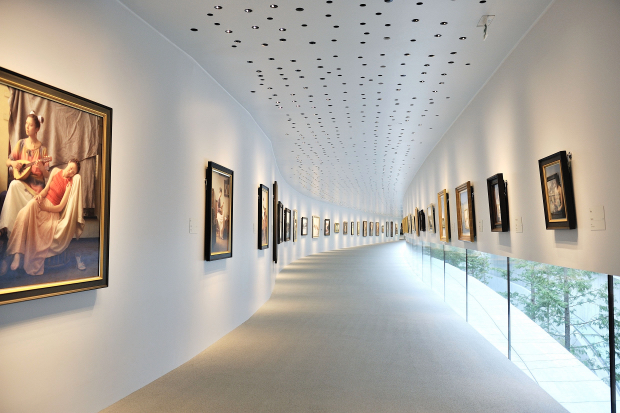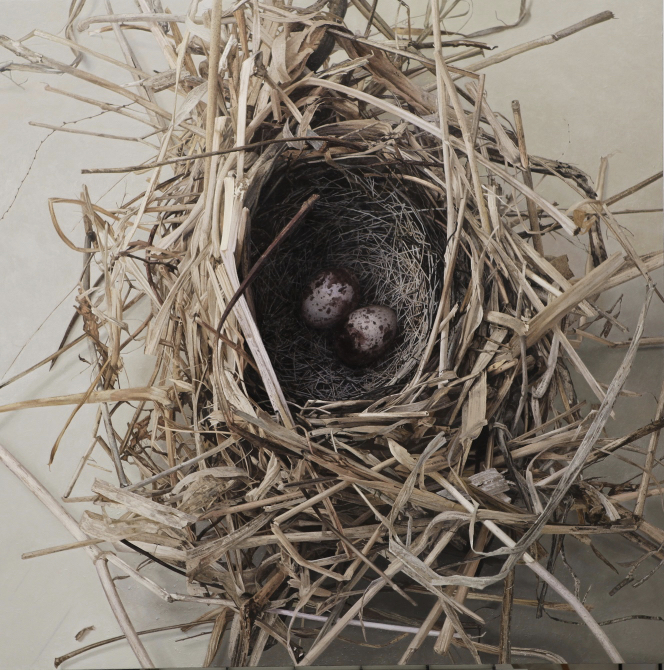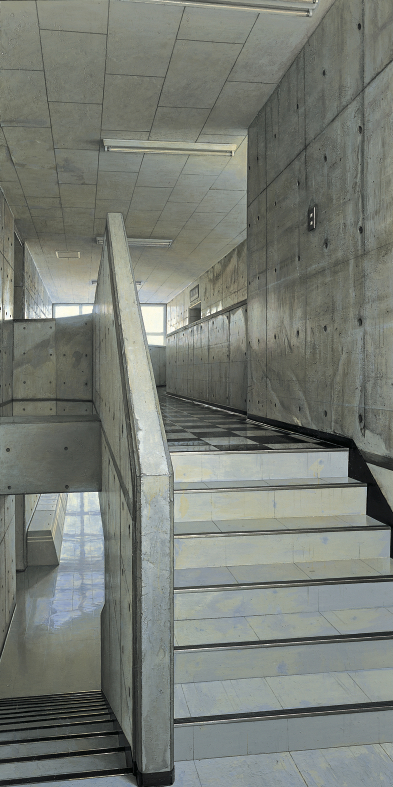 |
|
Here and There introduces art, artists, galleries and museums around Japan that non-Japanese readers and first-time visitors may find of particular interest. The writer claims no art expertise, just a subjective viewpoint acquired over many years' residence in Japan.
|
|
 |
|
|
 |
 |
It Gets Real: The Hoki Museum
Alan Gleason |
 |
Toshihiro Ohata, Atmosphere: Winter (2017), 162.1 x 162.1 cm |
Realist painting tends to get short shrift. The art world often seems infatuated with innovation of any sort, the less representational the better. I've been guilty of that bias too, particularly when it comes to photorealism, the attempt to mimic photography in painting. What comes to mind are the candy-colored works of Californian painters in the 1970s with their postcard-perfect depictions of sunny suburban houses with big shiny cars parked outside.
So it was intriguing to hear about the Hoki Museum, which opened in 2010 in Chiba, about an hour east of Tokyo, and touts itself as the world's first, and Japan's only, museum dedicated entirely to realist art. An added attraction was the museum itself, a prize-winning structure with a reputation as an architectural marvel.
Two views of the Hoki Museum |
The building, designed by Nikken Sekkei Ltd., did indeed prove to be worth a look on its own terms. Consisting of several long, gently curving, overlapping tubes, it resembles a double helix resting on its side. Though it has three stories, two are on or below ground level, while the top cantilevered section thrusts dramatically out into empty space. It's a stunning sight, particularly when viewed from the lush greensward of Showa-no-Mori Park, which flanks it on one side. If there is a shortcoming, it is that the narrow lot is hemmed in on the other side by a cookie-cutter housing development toward which it offers only a featureless concrete wall -- somewhat spitefully, it seemed.
Inside, this unorthodox design turns out to be ideal for an art museum. The long, bow-like galleries, a total of 500 meters' worth, gradually arc into the distance like the space station corridor in 2001: A Space Odyssey, and look just as futuristic. The paintings that line them are lit by arrays of LEDs at varying wavelengths embedded in the ceiling, and the walls are free of rails. It's one of the nicest museum interiors I've ever seen.
 |
|
Just as impressive, however, is the collection. Accumulated over the past three decades by Masao Hoki, founder of a major medical supply company, it currently boasts 480 works by some 60 artists -- nearly all Japanese and nearly all oil painters (the one outlier works in tempera). There are no acrylics in sight, nor, for that matter, Nihonga pigments. A curator explained that not only does oil have a track record for durability (specimens have survived, after all, since the Renaissance), but Hoki believes it is the most suitable medium for realist painting. Initially he kept his collection at his residence, which it eventually outgrew, as did the number of art aficionados beating a path to the door. The site he chose for his museum is located not far from his home in Chiba. Today Hoki's daughter Hiroko serves as director. A graduate of Le Cordon Bleu, Tokyo, she has brought additional flair to the museum experience through Hanau, a restaurant that draws customers who come for the food at least as much as for the art (reservations are recommended for lunch, but if you can't get in, there is a more casual café downstairs).
 |
|
Hiroshi Noda, The Sacred - Ⅳ (2013), 150 x 150 cm |
As for the works on display, they are a tour de force of meticulous renderings of the real world, as one would expect. The painters are without exception possessed of stellar technique, as well as superhuman dedication -- realism is surely the most technically demanding and time-consuming of all painting genres, with artists often taking a year or more to complete a single work. Most of the works at the Hoki are by artists who take pride in reproducing their subjects at larger than life-size, yet in the most minute detail conceivable. In the landscapes, every leaf, every blade of grass shines with a hyper-real, almost hallucinatory presence.
Fumihiko Gomi, Still-Life with Lemon (2009), 27.3 x 40.9 cm |
Still, that is an effect that can ostensibly be achieved by blowing up a high-resolution digital photo. The true revelation is an ineffable quality, a luminosity not found in photographs, that the best of these paintings exude. It is something that defies analysis, but I began to think that it was the light in these images that sets them apart from the reality we observe in photographs or with the naked eye. A good example is Fumihiko Gomi's Still Life with Lemon, in which a partially peeled lemon, a pear, and a chunk of French bread glow against a black background like distant planets reflecting the sun. In an excellent video with English voiceover that introduces artists and their works on the museum website, Ryo Shiotani describes painting a seascape as if it reflected two sources of light. Perhaps it is nearly imperceptible tricks like this that give so many of these paintings their surreal flavor. Or perhaps it is just the human factor. In the same video Gomi says, "I try to exclude all emotion when I paint, but the finished work is never completely mechanical. . . . Emotion is always there."
 |
|
Hiroshi Hada, Sakurajima in Early Autumn (2017), 97.0 x 145.5 cm |
Some artists, like Hiroshi Hada, employ a pointillist technique in their landscapes that further distinguishes their work from photographic imagery. But for the most part, the emphasis is on faithful replication of the physical world down to a level of detail that defies human perception, like sonic frequencies outside our range of hearing. This approach is applied to all manner of motifs, though the dominant ones in the Hoki collection are landscapes (many of them European), still lifes, and figures. The latter are mostly female, young, and nude. This appears to reflect not so much a preoccupation of the collector as of the artists, several of whom rhapsodize in their interviews about the exquisite translucency of human skin.
Nobuyuki Shimamura, Sunlight (2009), 40 x 80 cm |
Amid the plethora of beautiful bodies, mountains, and trees, it is refreshing to come upon the occasional work depicting, in the same loving detail, an industrial landscape or interior. Kenichiro Ishiguro's Shaft Tower (Akabira) portrays the vast, stark space inside the surface structure of an abandoned coal mine. Emi Hiroto's Stairwell exemplifies her concern with the empty hallways of unadorned concrete buildings. Hiroto explains that she is fascinated by the "rich presence and tactile feeling" she finds in such spaces.
Kenichiro Ishiguro, Shaft Tower (Akabira) (2010), 162.1 x 227.3 cm |
The museum's current special exhibition, That Initial Realist Spark: When You Were Young, juxtaposes early and later works by several artists in its collection. The objective is to show how the decision made at some point in their career to focus on realist painting transformed their styles and choices of subject matter. It's a promising concept, but the examples on display are not particularly revelatory. Most of the artists studied in Europe, where they started out painting classical landscapes or copying Vermeer or Rembrandt before finding their own realist "voice." A refreshing exception is the aforementioned Gomi, a Monoha-influenced painter of Daliesque works in his youth who still enjoys producing quirky collages of human faces, tableware, and taxidermy-stuffed animals.
|
 |
|
|
|
Emi Hiroto, Stairwell (2008-2009), 206.8 x 103.4 cm |
Of greater interest is a long-term exhibition (changing every three years) titled My Best Work. Occupying a large, dark, black-walled gallery, it introduces new paintings Hoki commissioned from 14 of his favorite artists. Offering each one six meters of wall space, he asks only that they provide large-scale works in the spirit of the series title. The results, and their ambience, are suitably spectacular. If you've ever been tempted to dismiss realist painting as old hat, take a trip out to the Chiba countryside, where the Hoki Museum will rapidly dispel you of that notion.
All images courtesy of the Hoki Museum. |
 |
| That Initial Realist Spark: When You Were Young (in Japanese only) |
| 24 May - 18 November 2018 |
| Hoki Museum (in English) |
3-15 Asumiagaoka Higashi, Midori-ku, Chiba-shi, Chiba Prefecture
Phone: 043-205-1500
Open 10 a.m. to 5:30 p.m.; entry up to 30 minutes before closing
Closed Tuesdays (or Wednesday when Tuesday is a public holiday), year-end/New Year holidays, summer vacation, and exhibition changeover days
Access: 20-minute walk or 5 minutes by bus or taxi from Toke Station on the JR Sotobo Line, about 1 hour from Tokyo Station |
|
|
|
| |
 |
Alan Gleason
Alan Gleason is a translator, editor and writer based in Tokyo, where he has lived for over 30 years. In addition to writing about the Japanese art scene he has edited and translated works on Japanese theater (from kabuki to the avant-garde) and music (both traditional and contemporary). |
|
|
|
|
|
|
|
|
|
 |
|